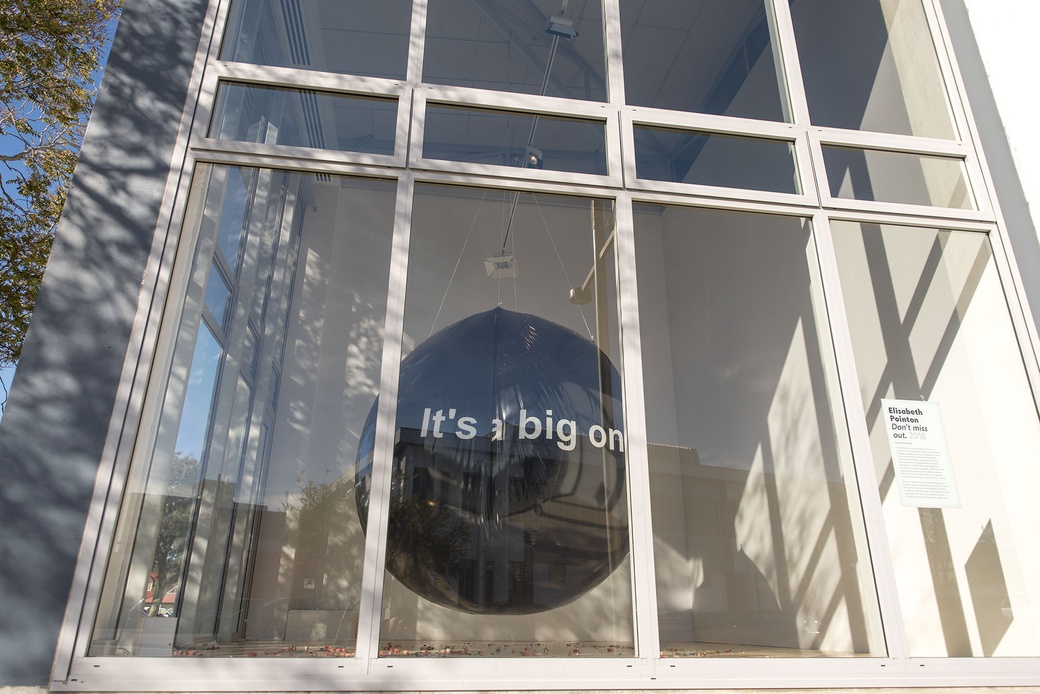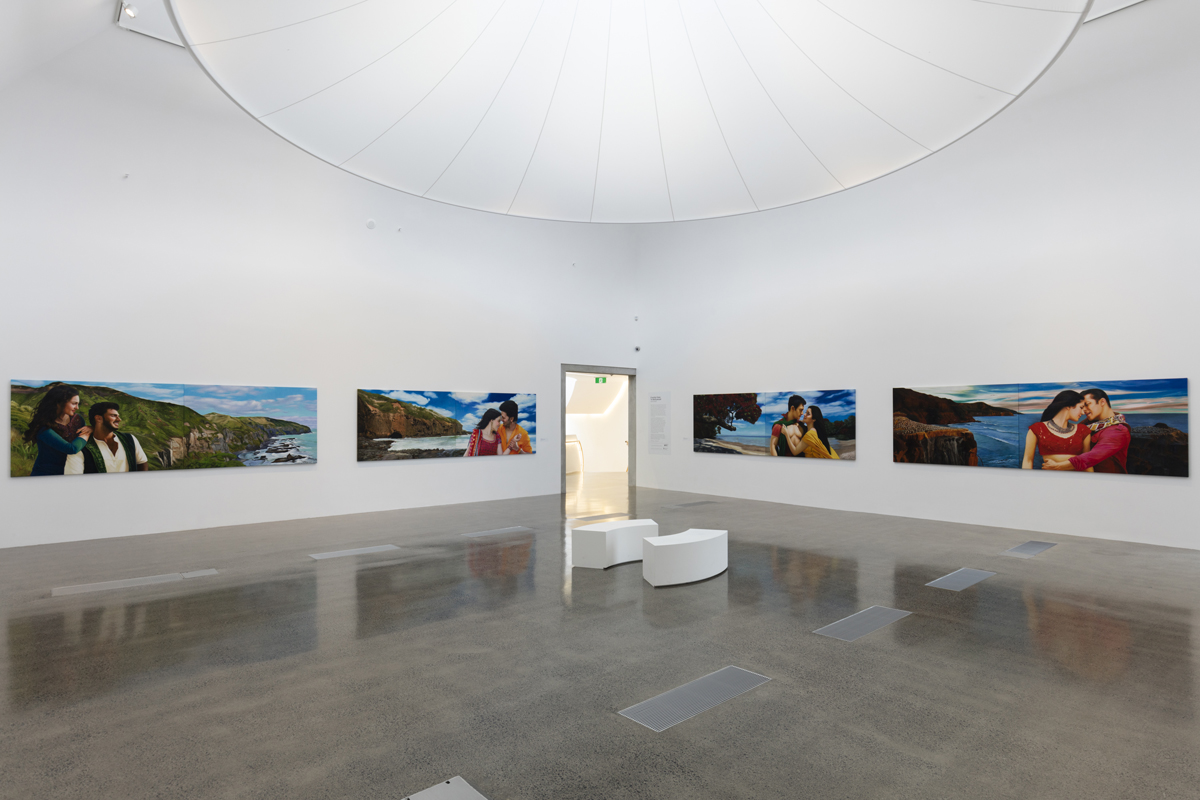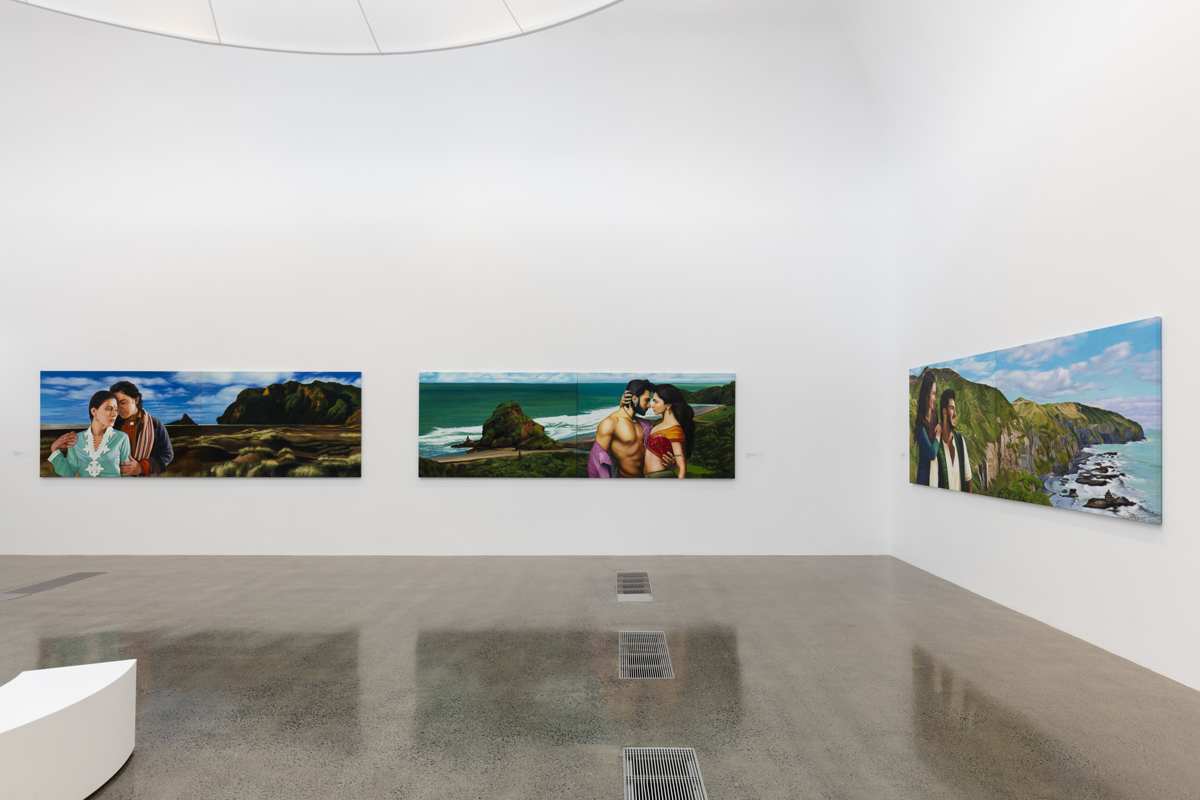

Notes
1In conversation with Nina Tonga, Pacific Art Curator at Te Papa, Singh stated “if the audience goes home with a feeling of well-being, connectedness, wholeness, with a deeper understanding of a social or political issue, then much has been achieved.”
Nina Tonga, “Rituals and Wellbeing: Tiffany Singh in Conversation,” Museum of New Zealand Te Papa Tongarewa, https://www.tepapa.govt.nz/discover-collections/
read-watch-play/art/tiffany-singh-indras-bow-
total-internal-reflection/rituals.
2“Q&A with Balamohan Shingade (Art Gallery Manager & Curator),” Business to Business, last modified November 16, 2016, http://btob.co.nz/q-a/balamohan-shingade-
art-gallery-manager-curator/.
3Unless otherwise noted, all quotations by Bepen Bhana are drawn from a conversation with the author, June 28, 2018.
4Unless otherwise noted, all quotations by Elisabeth Pointon are drawn from a conversation with the author, May 29, 2018.
5A title awarded to Pointon after persistent requests to her manager.
6“The burden [of] representation,” when discussed by Kobena Mercer, is described as the “desire to say it all”—to “speak for” an entire imagined group that you are a part of as a minority (in this case, a cultural minority). Kobena Mercer, Welcome to the Jungle: New Positions in Black Cultural Studies (London, Routledge, 1994), 233–58.
7Divya Tolia‐Kelly and Andy Morris, “Disruptive Aesthetics? Revisiting the Burden of Representation in the Art of Chris Ofili and Yinka Shonibare,” Third Text 18, no. 2 (2004): 153–67.
8Bepen Bhana and Kelly Carmichael, The Leif Garrett Fan Club (Auckland: FERARi, 2013). Exhibition booklet.
9Maslow’s Hierarchy of Needs is a theory that explains the different layers of human needs. The bottom tier is about having basic needs met—food, water, warmth and rest—while at the apex is self-actualisation, which is also self-fulfilment. Artistic endeavours have often been said to fall into this top category as it describes the desire to accomplish things that personally fulfil them as individuals. When the needs of one tier are met, the person proceeds to the next.
10Colmar Brunton Research Agency, “New Zealanders and the Arts: Attitudes, Attendance and Participation in 2017,” Creative New Zealand, February 2018, http://www.creativenz.govt.nz/assets/
paperclip/publication_documents/
documents/633/original/new_zealanders_
and_the_arts_2017_full_report.pdf?1526986665.
11In conversation with Te Uru’s visitor host team, July 19, 2018.
12Jacob Rajan and Justin Lewis, Indian Ink (Wellington: Victoria University Press, 2005).
13Leonard Feinberg, The Secret of Humor (Amsterdam: Rodopi, 1978).
Representation and Humour in South Asian Aotearoa Art
South Asian cultures have rich histories that have travelled with us as we have migrated. They remain with us as we have created communities in different lands, including Aotearoa. The South Asian community in Aotearoa is comprised of a diverse group of people and as a result creative practitioners working within these communities have varied approaches. As a Sri Lankan New Zealand artist and writer, I find the critical discourse around contemporary art by South Asian practitioners, or exhibitions and work that explore the South Asian Aotearoa experience, insufficient. This is the first of two texts that will critically reflect upon the insights and work of South Asian artists, writers and curators within Aotearoa’s contemporary art scene. It weaves together conversations with artists Bepen Bhana and Elisabeth Pointon, and curator Balamohan Shingade, to address different facets of South Asian Aotearoa experience. I have brought together these different voices and practices to begin to explore some of the issues this community is concerned with. I reflect on how these practitioners tackle those concerns through contemporary art and exhibition-making. This includes a focus on the use of humour in Bhana’s and Pointon’s artistic practices.
Representation
Firstly, however, I want to take a look at the spaces that exhibit work by South Asian Aotearoa Artists and institutional biases towards showing their work. While researching this piece, I searched through the online archives of major contemporary art institutions such as City Gallery Wellington, Auckland Art Gallery Toi o Tāmaki, The Dowse Art Museum and Dunedin Public Art Gallery. I couldn’t find many examples of South Asian Aotearoa Artists that have been exhibited. Here is what I did find. In 1995, Sanjay Theodore was included in two group exhibitions at City Gallery Wellington: The Nervous System and A Very Peculiar Practice. In 2011, Tiffany Singh’s work was shown at The Dowse Art Museum—located in the Hutt Valley, a region that is very ethnically diverse and has a large South Asian community—in an exhibition called Crystal City that brought together artists from Asia and New Zealand artists of Asian descent. Singh was the only South Asian Aotearoa Artist in the group of eight exhibiting practitioners. Dunedin Public Art Gallery exhibited Singh’s OM MANI PADME HUM (2016–2017) as a large-scale installation against the gallery’s ‘Big Wall’. Auckland Art Gallery Toi o Tāmaki has failed to show international South Asian Aotearoa Artists as part of the Auckland Triennials for the past seventeen years, although they did exhibit Singh’s May the Rainbow Always Touch Your Shoulder (2012) in their Todd Foundation Creative Learning Centre. This is, as far as I can tell, the only solo exhibition by a South Asian artist (based in Aotearoa or internationally) that the gallery has shown.
Institutions located outside major city centres and in areas with higher immigrant populations have exhibited South Asian Aotearoa artists more frequently. However, in comparison to the number of artists of other ethnicities and cultural backgrounds shown, the numbers are still dismal. Some notable projects include Indian New Zealand artist Nandita Kumar’s solo exhibition Tentacles of Dimensions and Birth of BrainFly (2017–2018) at Pātaka Art + Museum. The gallery is located in Porirua, a city about 30km north of Wellington central, and has a great track record of showing art that reflects the cultural diversity of the community it is situated within. Pātaka often shows Māori and Pasifika art, but prior to Kumar, the last South Asian Aotearoa artist to be shown was Singh in 2014. Another less-centrally located gallery, Te Tuhi Centre for the Arts in Pakuranga has shown Bhana’s Postcards from the edge (2013) and The Facial Suite (2012), as well as various exhibitions stemming from residencies in South Asia but not by South Asian artists. The group exhibition The Asia-Pacific Century (2016) at Enjoy Public Art Gallery, which featured contributions from Bhana and Shingade, had its second iteration at Te Uru Waitakere Contemporary Gallery in 2017.
After looking through the archives of these institutions, not only can we see that the display of art by South Asian Aotearoa artists is rare, but that it tends to be the same few artists who receive these opportunities. Singh presents a caricature of cultures from the Indian sub-continent that have already been exoticised and appropriated, emphasising the importance of well-being and connectedness, concepts that are scattered in Western adoptions of practices such as yoga and meditation.1 Singh is shown widely throughout Aotearoa and is often used to represent our South Asian population in galleries. She is of Pasifika and Asian descent, but her work perpetuates ideas of non-specific Eastern spirituality that are already fashionably embraced and therefore easily marketable in Western cultures.
I recognise that there will be inevitable inaccuracies in briefly surveying the landscape of South Asian representation through galleries’ online archives. Artists’ names from group exhibitions and particular events may not be recorded on these websites, and attempting to identify an artist’s cultural background solely through their name or their artist bio is limiting. Names do not necessarily signify one’s ethnicity and artists are not obligated to tailor their bios to reflect their cultural background. However, by taking a broad look back through the readily available records to the very beginning of the online archive of each gallery discussed here, it is clear that there are very few South Asian Aotearoa artists who have exhibited at public galleries over the past few years. Prior to 2011, there are even fewer.
While working on this piece, I spoke with Balamohan Shingade, a writer, curator, Indian classical musician and assistant director of ST PAUL St Gallery. We discussed the generational gaps in the timeline of South Asian New Zealanders creating contemporary art and the varied but small group of artists who are currently practising in this field. Prior to his role at ST PAUL St Gallery, Shingade was the manager and curator of Malcolm Smith Gallery in East Auckland—a region where close to 40 percent of the population identifies as Asian. During his time there he stated that the gallery “aims to connect to a wide network of art institutions, practitioners and audiences around the Asia-Pacific rim to show a leading example in shaping the success of Asian arts and cultural practices in New Zealand.”2 Through his musical and curatorial practices, Shingade exhibits his desire to encourage cultural diversity within the arts. As a classical Indian musician he has performed throughout Auckland and in his role at ST PAUL St Gallery—a space that predominantly exhibits artists of colour—he has co-convened the last two symposiums they hosted; both of which included a variety of topics concerning several cultural groups and included culturally diverse presenters.
One of the practitioners I discussed with Shingade was Bepen Bhana, an interdisciplinary artist whose interest in pop culture is prominent throughout his practice. Bhana’s father migrated to Auckland from India in 1947. In my conversation with Bhana, he mentioned that when it was initially suggested he and Shingade work together, the person who proposed the connection didn’t want it to be a case of “mates helping out mates”—implying that they already knew each other and would work to serve their own interests instead of the organisation that pushed them together.3 This idea that South Asian artists operate as a hidden collective aside from the rest of the contemporary art world, and that all who are within that group are familiar with each other, is an unsubstantiated myth. Creative practitioners with South Asian heritage are few and far between in Aotearoa, and since they are not regularly shown in contemporary art spaces or discussed in contemporary art discourse it is difficult for practitioners to find one another in order to create connections.
Humour
For many minority artists, it is difficult to approach aspects of our cultural experiences in a humorous way or incorporate humour into our work because so many of our experiences in Eurocentric art spaces are directly influenced by prejudice. Minority practitioners are constantly aware that the people who are actively welcomed into contemporary art spaces are predominantly Pākehā. Due to this structural imbalance it can be tricky to use humour effectively to refer to South Asian experiences without reiterating stereotypes to an audience that is relatively unfamiliar with the complexities of our cultures.
Elisabeth Pointon is a Wellington-based artist born in the early ’90s who was raised in the Hutt Valley region, and is both Pākehā and Fijian-Indian. While speaking with Pointon, she told me she believes that “if you do use humour you have to be delicate with it because otherwise you can feed into stereotypes. We often use those same tropes to try and reclaim them, but it can be misunderstood or misinterpreted completely.”4 While occupying the role of bookings co-ordinator and artist-in-residence at a luxury car dealership,5 Pointon created a body of work that responds to the toxic social imbalances in her workplace. She presented a wacky inflatable waving-man, whom she named Chrystal, in the car showroom and threw HR-style “work parties” in the shared break room with balloons and a wide banner with the statement “You are special.” Pointon made an otherwise-trying environment into one embellished with moments of ridiculousness and endearment. While discussing her use of humour, Pointon explained that she believes “jokes are [a] good way to insert yourself into a conversation and keep yourself safe at the same time.”
Pointon’s exhibition, Don’t miss out. (2018), displayed in the window of The Dowse Art Museum, consisted of an enormous black inflated blimp printed with white text stating “It’s a big one.” In discussing the burden of representation,6 Divya Tolia-Kelly and Andy Morris explain that “the audience’s gaze is tainted because the project of art is still an exclusive one, which continues to occlude on the basis of gender and race. These exclusions continue to skew the lens away from exploring the intrinsic, aesthetic qualities of artistic production.”7 Pointon acknowledges this skew by obscuring markers of her cultural identity from the audience. The installation also uses the impersonal monochromatic aesthetic of work email and e-newsletters and the generically positive statements of affirmation that are used in them.8
Don’t miss out., like many of Pointon’s works, critiques institutional bias and the structures of power that determine value within visual culture and places of employment. The dark object occupying the window was intentionally made as large as possible. Pointon understands that galleries don’t often make space for artists who are South Asian, brown and female, so she made the most of the opportunity by taking up as much space as she could. The phrase “it’s a big one” obviously—even sarcastically—refers to the size of the blimp, while simultaneously pointing out that displaying this work at The Dowse Art Museum is a significant milestone for the artist. Pointon’s work uses sharp wit, which allows for it to be accessed at a surface level without prioritising any metaphorical significance that may have been given to the work. Pointon said that she overheard a mother talking to her child about the work asking “what is it?” and her child replied “it’s a big one,” a response that Pointon enjoyed, exclaiming that “she got it!” Other viewers may ask themselves “Did I miss something?” Don’t miss out. is littered with in-jokes that come from the difficult experiences she has encountered as a woman of mixed-race, specifically in the work place and art institutions. As Pointon notes, “humour is a way to invite people in, but shut them out at the same time.” Pointon refuses to create work that explains these experiences to a majority audience; instead she uses her practice to ease herself from those circumstances by creating some comic relief.

Elisabeth Pointon, Don’t miss out., 2017. Courtesy of the Artist and The Dowse Art Museum. Photo: John Lake.
Like Pointon, Bhana creates work that counteracts the expectation to solely explain their minority experience to a wider audience. His eccentric fixation with unconventional and often dated figures from Western media is evident when looking at his oeuvre. In 2013, Bhana presented The Leif Garrett Fanclub at artist-run initiative FERARi, a refurbished garage turned exhibition space. His paintings paid homage to the ’70s pop icon Leif Garrett, a teenage heart-throb who later became more widely known for his run-ins with the law, drug addiction and troublesome love life. The paintings depicted Garrett in his heyday, with perfectly flicked long blonde hair, immaculate smile, skateboard and a lot of boyish charm. Accompanying the paintings was a Leif Garrett “activity pack” of the same title, which contained Garrett ephemera created by Bhana. This included a colouring book (that simultaneously acted as an exhibition catalogue), Leif Garrett brand felt pens, a signed photo and a poster. Bhana’s exploration of niche pop figures was also seen in The Curry Bunch (2012) at Govett-Brewster Art Gallery’s Open Window space, showing painted portraits of the cast of the cheesy American sitcom The Brady Bunch, all donning bhindis.

Bepen Bhana, Frankie Goes to Bollywood, 2016. Image courtesy of Sam Hartnett and Te Uru Waitakere Contemporary Gallery.
Bhana has continued to merge Eastern and Eurocentric cultures through the analysis of popular media in Frankie Goes to Bollywood (2016), exhibited at Te Uru Waitakere Contemporary Gallery. In Shingade’s review of the exhibition, he explained that “Bhana recognises the uneven playing field in which representation occurs, and shows in his paintings that Indians already set their own standards and ideals, and inspire their own audiences.” The exhibition title plays on the popular ’80s British band Frankie Goes to Hollywood. The oil paintings displayed iconic couples from Bollywood movies in front of scenic backgrounds shot in Aotearoa, presented as large-scale diptychs. Bhana was equally inspired by the colonial histories of oil painting and art schools in British India during the 18th century and the work of graphicwallahs, film hoarding painters who worked from small postcard-sized images to create the painted equivalent of a movie billboard.
The amalgamation of pop references, Bollywood stars and Aotearoa landscapes in Frankie Goes to Bollywood presents audiences with scenes and names they’re familiar with, building an almost immediate dialogue that does not require knowledge of art history—which is much the same as his previous exhibitions. Bhana explains that he uses humour to engage the audience at a surface level, and though ideally they would evaluate the work in more depth, he accepts that may not always be the case. The display of these bizarre and intricate representations of pop media icons makes these exhibitions feel like heightened and complex fanfiction, a culture that many people ridicule, and legitimises a form that is often not taken seriously.

Bepen Bhana, Frankie Goes to Bollywood, 2016. Image courtesy of Sam Hartnett and Te Uru Waitakere Contemporary Gallery.
The depiction of Bollywood characters is a direct reference to Indian culture—a culture that many contemporary spaces don’t often acknowledge. When Frankie Goes to Bollywood was exhibited at Te Uru, Bhana indicated that for many South Asian audience members it was the first time they had entered a contemporary art gallery. In addition to the lack of representation of South Asian artists in galleries and museums, the issue of class also influences engagement with contemporary art. Bhana mentioned that the generation before him had difficult lives that were about survival—using Maslow’s Hierarchy of Needs9 to quantify why the generation before him were not engaged in art. This theory can be applied to many South Asian communities within Aotearoa, especially their older generations, large majorities of which are predominantly working class. This is reflected in the New Zealanders and the Arts 2017 report, where only 15 percent of Asian New Zealanders interviewed for the survey said they regularly participated in the arts and 42 percent of Asian New Zealanders believed that “the arts are not wholly inclusive and only for certain types of people.”10 Alongside this exhibition, however, Te Uru hosted Indian Film Weekend and an Indian Music Concert. Frankie Goes to Bollywood had approximately ten thousand visitors with these satellite events included.11 As Shingade notes in his review, “Bhana does not depict Indians succeeding in the Pākehā mainstream, but rather on their own terms.” The number of attendees for Frankie Goes to Bollywood shows that there is a desire to engage with South Asian practice, and points to a future where, if the opportunities arise, South Asian Aotearoa engagement with the arts may be less of a rarity. That is not to say that the only art that cultural minorities enjoy is art made by their peers, but it does show the importance of creating spaces within which they may feel welcome.
In their book Indian Ink, playwrights Jacob Rajan and Justin Lewis describe how laughter is “our Trojan horse. With it we are able to gain entry through the fortified gates of a cynical world. The soul is so much more easily nourished with a belly full of laughter.”12 This rhetoric is reflected in both Bhana and Pointon’s practices. Though both artists have very different backgrounds and are of different generations, they use grand gestures, large scale and multiplicity to weave humour and enjoyment into often-sterile environments with a critique of the Eurocentric societal and gallery structures that the artists are working within.
The superiority theory of humour states “people laugh outwardly or inwardly at others because they feel some sort of triumph over them or feel superior in some way to them.”13 Since a large proportion of Asian New Zealanders already feel like art isn’t inclusive, humour, in particular, could cause audiences to feel that they aren’t in on the joke or that the joke is on them. Despite this, I don’t believe minority practitioners should remove humour from their work, or have to constantly adhere to the pressure to create art that represents or integrates their communities. This pressure can confine artists to making explanatory instead of exploratory works, which can inhibit the growth of the art being made by artists from those minority groups.
Humour can be used by artists as a tool to entice audiences to engage with the witty nature of their works, and can include complex underlying ideas that audiences may not otherwise be drawn to. Both Bhana and Pointon use politically driven forms of humour to confront inadequate visibility for South Asian Aotearoa artists—using their exhibiting platforms to subtly address how this diverse group of the country’s population is insufficiently integrated in the New Zealand art industry. These artists’ bizarre and amusing approaches to art-making remove cultural stereotypes and present a less generic view of South Asian Aotearoa experiences. As South Asian Aotearoa artists, writers, curators and creative practitioners, our ability to create networks and discourse has the potential to expand the definition of art in Aotearoa to better reflect our multicultural population—a goal that I, as a Sri Lankan New Zealander, believe can benefit the growth and greater understanding of our communities and us as individuals.